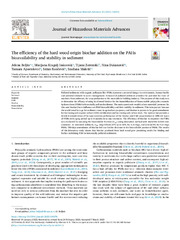| dc.creator | Beljin, Jelena | |
| dc.creator | Kragulj Isakovski, Marijana | |
| dc.creator | Zeremski, Tijana | |
| dc.creator | Đukanović, Nina | |
| dc.creator | Apostolović, Tamara | |
| dc.creator | Rončević, Srđan | |
| dc.creator | Maletić, Snežana | |
| dc.date.accessioned | 2023-10-17T12:02:21Z | |
| dc.date.available | 2023-10-17T12:02:21Z | |
| dc.date.issued | 2023 | |
| dc.identifier.issn | 2772-4166 | |
| dc.identifier.uri | http://fiver.ifvcns.rs/handle/123456789/3827 | |
| dc.description.abstract | Polluted sediments with organic pollutants like PAHs represent a potential danger to environment, human health and potential obstacle to water management. Removal of polluted sediment provides the potential for reuse of nutrients from sediment, for crop production or for materials in building industry. The purpose of this study was to determine the efficacy of using hard wood biochar for the immobilization of bioaccessible polycyclic aromatic hydrocarbons (PAHs) in historically polluted sediment. The main question is would carbon materials' presence (in this case biochar) have influence on PAH bioavailability and their stability in sediment. This is important because the world trend is to go for sediment reuse in agriculture purposes, and biochar is proven to be good amendment for increasing soil organic carbon (SOC) stabilization and increasing soil carbon stock. The manuscript provides a detailed consideration of the supersorption performance of the biochar and PAH sequestration in different types of PAHs with aging period up to 6 months in ex situ treatment. The efficiency of biochar to sequester the PAHs was evaluated by assessing the bioavailable fraction (Frap) using desorption method with Amberlite XAD4 resin assistance. In untreated sediment, Frap ranged from 22% up to 42% for 2–4 rings, and around 9% for 5–6 rings PAHs. 180-days amendment of biochar led to a further decrease in the bioavailable portion of PAHs. The results of this laboratory study shown that biochar produced from hard wood gave promising results for binding and further stabilizing PAH in historically polluted sediments. | sr |
| dc.language.iso | en | sr |
| dc.publisher | Elsevier | sr |
| dc.relation | APV 142-451-3182/2022-01/2 financed by the Provincial Secretariat for Higher Education and Scientific Research, AP Vojvodina | sr |
| dc.relation | Twinning excellence on organic soil amendments effect on nutrient and contaminant dynamics in the subsurface project (TwinSubDyn), HORIZON-WIDERA-2021-ACCESS-02, Funded by the European Union | sr |
| dc.rights | openAccess | sr |
| dc.rights.uri | https://creativecommons.org/licenses/by-nc-nd/4.0/ | |
| dc.source | Journal of Hazardous Materials Advances | sr |
| dc.subject | sediment | sr |
| dc.subject | sorption | sr |
| dc.subject | PAH | sr |
| dc.subject | biochar | sr |
| dc.subject | bioavailability | sr |
| dc.subject | remediation | sr |
| dc.title | The efficiency of the hard wood origin biochar addition on the PAHs bioavailability and stability in sediment | sr |
| dc.type | article | sr |
| dc.rights.license | BY-NC-ND | sr |
| dc.citation.spage | 100276 | |
| dc.citation.volume | 10 | |
| dc.identifier.doi | 10.1016/j.hazadv.2023.100276 | |
| dc.identifier.fulltext | http://fiver.ifvcns.rs/bitstream/id/9641/bitstream_9641.pdf | |
| dc.identifier.scopus | 2-s2.0-85164082517 | |
| dc.identifier.wos | 001041046200001 | |
| dc.type.version | publishedVersion | sr |


